Home composting is a great trend to get behind! Not only do you help lower your carbon footprint and reduce waste, but you also save money by creating your own organic compost for your flower or vegetable garden.
If you want to start composting, you need a good quality compost bin, so we’ve put together a list of the best compost bins for 2024.
More...
Top Pick

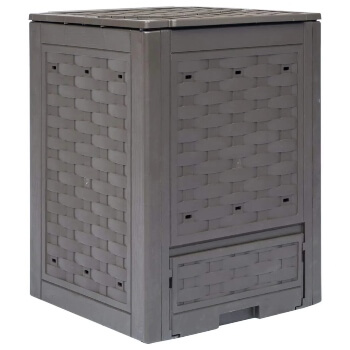
Premium Choice

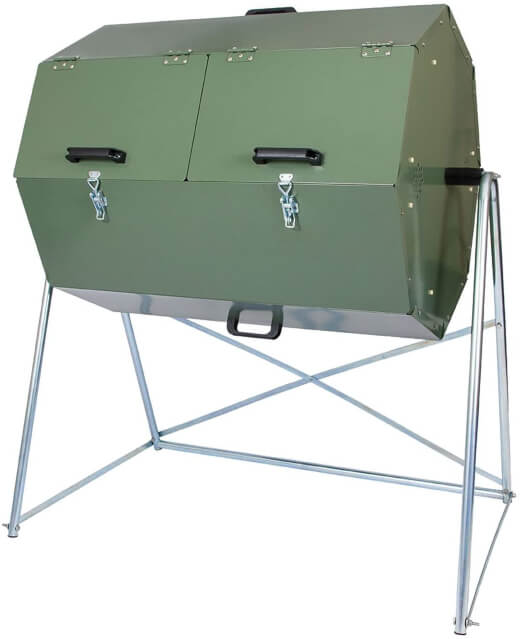
Best Value

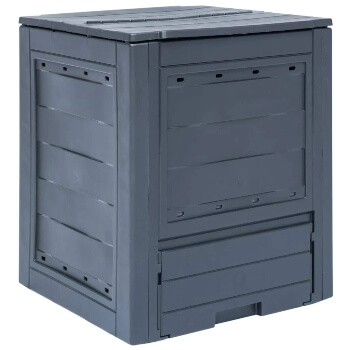
Best Compost Bins in Australia
Product | Our Rating | Price | |
|---|---|---|---|
1. Garden Composter Brown 60x60x83 cm 300 L | 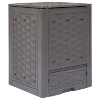 |  | |
2. Garden Composter Grey 60x60x73 cm 260 L | 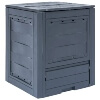 |  | |
3. Joraform 'Big Pig' Rotational Composter | 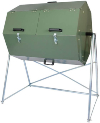 |  | |
4. FCMP Outdoor IM4000 Tumbling Composter | 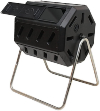 | ||
5. Compost Master Large Compost Tumbler Bin | 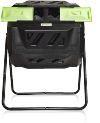 | ||
6. SQUEEZE Master XXL Large Compost Bin | 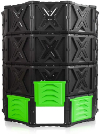 | ||
7. Eco R Us Worm Farm Composter | 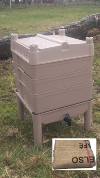 | ||
8. VermiHut Plus 5-Tray Worm Compost Bin | 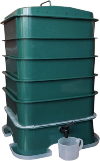 |
Compost Bin Buying Guide
Benefits of a Compost Bin
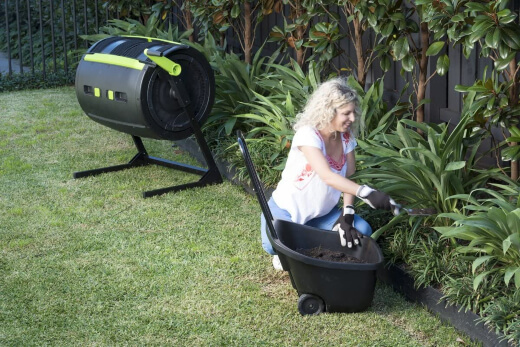
- Enriches Soil - Composting is an easy way to add organic matter to your planters, flowerbeds, vegetable garden, and lawn. By enriching the soil, you’ll improve your harvest, create the right environment for new plants to thrive, and lower risks for diseases and pests.
- Save Money on Chemical Fertilisers - If you’re producing enough compost, you won’t have to buy compost or soil enrichers like fertilisers, helping you save money.
- Makes Composting Easy - Composting can be quite a chore, but not when you have the right bin! With today’s products you can install a compost bin outside, in your garage, or in your kitchen, making it easy and fuss-free to compost.
Also read: Why there are maggots in your compost and whether it is good or bad to have them. - It’s Great for the Environment - Composting reduces methane emissions, improves your garden’s ecosystem, lowers how much of your waste ends up in a landfill, and reduces your carbon footprint. (Don't miss our guide to green waste removal for more info.)
Types of Compost Bins
There are plenty of different compost bins on the market, and the most common types are:
Countertop Compost Bins
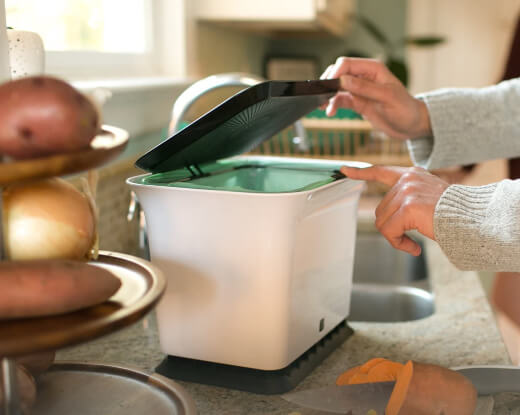
Kitchen compost bins are small containers where you can gather your scraps before you take them outside to add them to your compost. They are fully sealed and have charcoal filters, so there’s no risk of unpleasant smells or attracting pests.
All you have to do is fill it through your week with scraps, then dump it into your composter when it’s full. These compost bins are very affordable and are usually designed to look great too!
They tend to have very good filters, so there’s no risk of smell, but they are limited in capacity.
Stationary Outdoor Compost Bins
These are usually constructed of durable materials and are designed to create the right environment for organic materials to break down. They have ventilation, but are designed to prevent pests like rats from getting in.
These compost bins are often the most affordable type and have a large capacity. They do work a bit slower than other types and you will have to mix the compost yourself.
Compost Tumbler
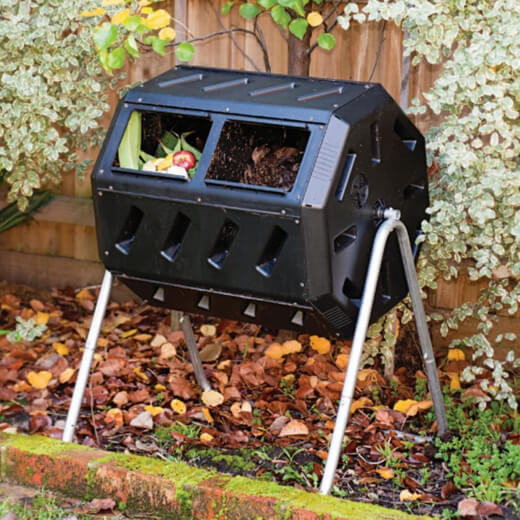
In order to make compost, you need to mix the materials every few weeks. The compost tumbler is a type of outdoor compost bin that takes a lot of the work out of this job!
It’s barrel-shaped and up on legs, so you simply use a handle to rotate the drum as needed. Compost tumblers create compost quickly, use minimal manual labour, are easy to use, and are more animal-proof than other types.
Worm Composting Bin
Also called worm farms, these are a great option for outdoor home composting, especially if you don’t generate a huge amount of composting material. It’s made of stacked containers that have ventilation and a tap on the lowest level.
You’ll use a specific earthworm species that love kitchen scraps, and all you have to do is keep the containers in a shaded, cool spot (even a shed will do), sprinkle with water from your retractable hose reel to keep the environment moist for the worms, and add your scraps on a weekly basis.
The worms and compost produce a liquid called worm tea, which is a fantastic fertiliser and can even be used as an organic insecticide.
They’re low maintenance, can be used indoors, take up very little space, and are a great educational tool – although they can be more expensive.
How Do I Choose a Compost Bin?
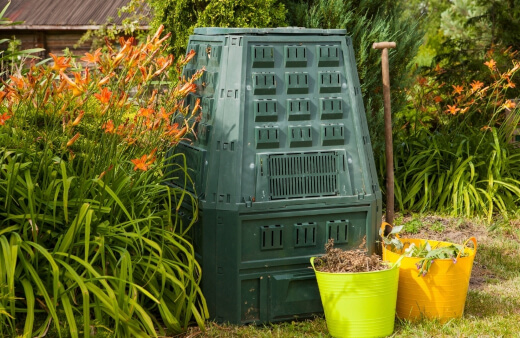
When looking for a compost bin, take into account the following factors to help find the right one for you.
- What You Want to Compost - If you are looking to compost kitchen food scraps, then a countertop compost bin or worm farm is a great choice.
If you are also composting grass clippings and garden waste, you’ll need something a bit bigger, like a compost tumbler or stationary outdoor compost bin.
- Your Composting Goals - If you want to do large-scale composting for your garden or vegetable beds, then you’ll need one or even two large-size tumblers, outdoor bins, or a combination of a tumbler and a composting pit.
If you want to reduce your food waste, then a countertop compost bin or worm composting bin are a better option. If you want to try to bring more organic gardening into your space, a worm farm can be a great way to produce organic fertiliser and insecticides.
- Your Location - If you live in an apartment with no garden, you can still compost using a countertop composter or worm farm. If you have a garden or large outdoor space, then an outdoor composter or large tumbler will work well.
(Check out our in-depth article on the best worm farms in Australia to learn more about worm farms and how it works.)
Features to Look for in Compost Bins
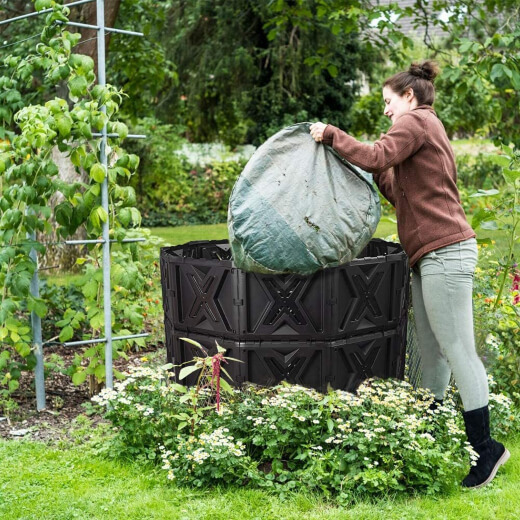
Before you buy, look for compost bins with these features.
- Size - It’s all about finding the right size for your composting needs! Larger compost bins are great if you have a lot of organic material and garden waste to compost, but they do take longer to produce usable compost.
Smaller compost bins can be more practical and convenient, as they produce compost more quickly. You want a size that will accommodate your waste production and create compost as quickly as possible for that volume. - Odour Control - Composting can get a little smelly, and that can be a problem – especially if your bin is indoors or on a balcony. Look for compost bins that feature air vents and charcoal filters to keep any odours under control.
- Durable Construction - Compost bins can be made out of a range of materials, including plastic, wood and metal. It might not sound very eco-friendly, but a thick, dark plastic construction is often the best choice.
You can look for a recycled plastic bin too! This is because plastic compost bins absorb heat well, lock in moisture, and create the perfect environment for organic materials to break down.
Look for a compost bin that is rated for outdoor use, so that it will last for years to come. - Dual Chambers - When a tumbling composter is divided into two chambers, you get a continuous flow of compost because you can fill one side, leave it to mature and break down, and start on the other side with new organic waste.
Compost Bins Reviews
1. Garden Composter Brown 60x60x83 cm 300 L

Source: kingswarehouse.com.au
This simple composter is a budget-friendly, but very well-designed bin, with ventilation in just the right places, and a lid that opens up on both sides for easy access.
The simple base flap opens up so you can access your oldest compost quickly without turning the whole lot at once too. It’s also pretty good-looking as far as compost bins go, and would easily blend into a garden with other plastic rattan furniture or storage solutions.
Pros
Cons
2. Garden Composter Grey 60x60x73 cm 260 L

Source: kingswarehouse.com.au
This basic grey garden composter might not have the looks of their other models, but it’s designed to be budget friendly; made from simple materials, and well-constructed.
The split lid is ideal for filling and topping up, with holes along the top, base, and centre for ventilation ensuring aerobic decomposition of all your garden and kitchen waste.
Pros
Cons
3. Joraform 'Big Pig' Rotational Composter

Source: amazon.com.au
If you want a premium-quality, heavy duty composter that can keep up with a lot of garden waste, this option is ideal. It holds up to 270 litres of compostable materials, and is suitable for pet droppings in addition to meat, vegetable, fruit and garden waste.
It processes 25-30 litres of waste each week, and has a 2-year warranty for peace of mind.
Pros
Cons
4. FCMP Outdoor IM4000 Tumbling Composter
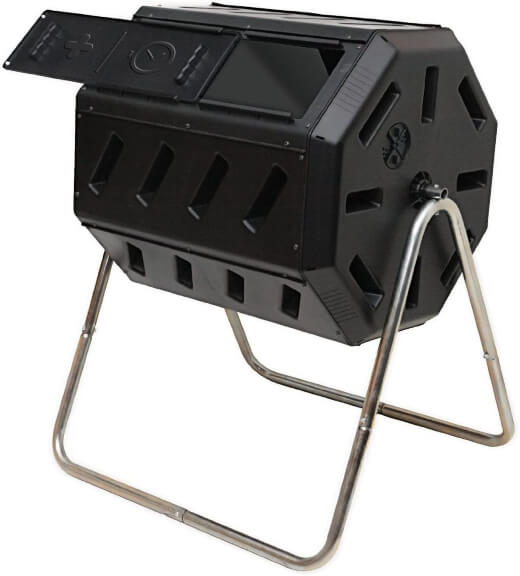
Source: amazon.com.au
With a sturdy, compact design, this tumbling composter will fit in well in any garden. It is designed to handle organic kitchen and garden waste, breaking it down into compost in a relatively quick amount of time.
It’s easy to use, designed to prevent pests from getting in, and the barrel is made of durable, BPA-free, UV-inhibited recycled polypropylene, so it’s got good green credentials and is built to last, handling sunny spots with ease.
It has some great additional features too, like dual composting chambers, adjustable air vents, and deep fins to help break up organic materials while ensuring good aeration.
Pros
Cons
5. Compost Master Large Compost Tumbler Bin
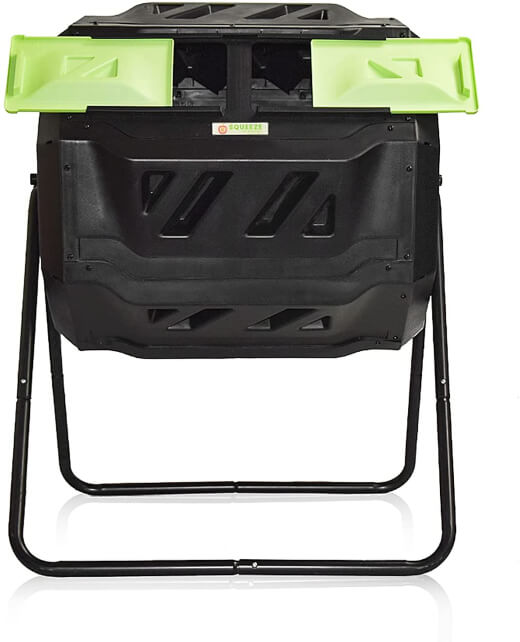
Source: amazon.com.au
Another good tumbling compost bin is this option from Compost Master. With a 140 litre capacity, it’s good for small gardens and families who produce a relatively small amount of food waste.
All you have to do is add your organic waste, turn it every 2-3 days, and you’ll have high quality compost in just 2 weeks.
It features a dual composting chamber, has excellent aeration, and is constructed of PA free, UV inhibited, 100% post-consumer recycled polypropylene that’s contact safe and won’t degrade under direct sunlight.
Pros
Cons
6. SQUEEZE Master XXL Large Compost Bin
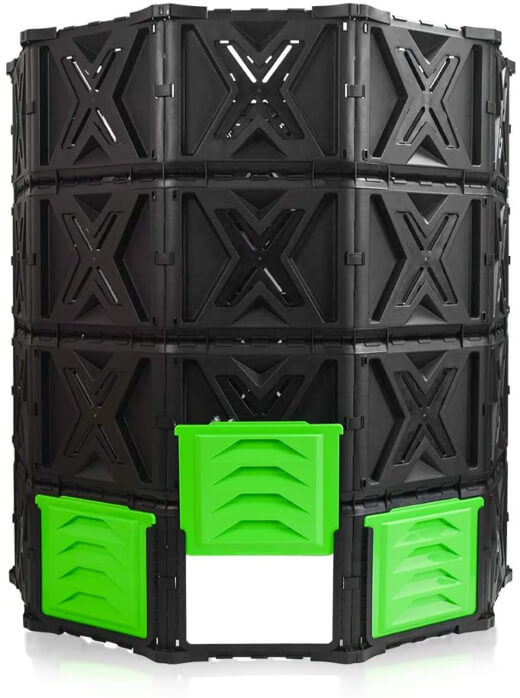
Source: amazon.com.au
If you are looking for a stationary compost bin with a high capacity, this is a great option. It has a capacity for 720 litres of organic matter and is durably constructed from high-quality BPA-free plastic that is designed to be cold-resistant.
Assembly is very easy as it is completely tool-free, and the completed bin weighs just over 10kgs. The ventilation system ensures that there’s a good flow of air to help support rapid composting, and the company is known for great after sales support
Pros
Cons
7. Eco R Us Worm Farm Composter
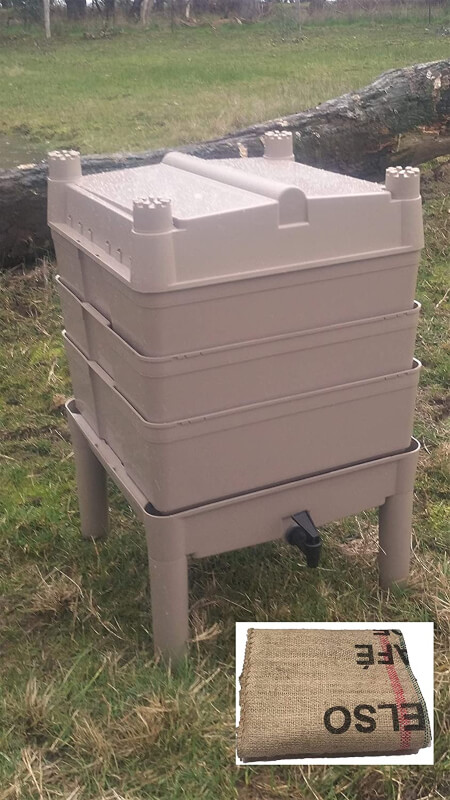
Source: amazon.com.au
We’re a huge fan of worm composting bins – they’re great for producing fertiliser and they’re plenty of fun for the kids! This is an Australian-made vermiculture composter that features three trays, hessian sacking for bedding and a tap for collection.
It’s made of 100% recycled UV resistant plastic and is very sturdy. It can be placed in a garage, shed or shady spot outdoors, and it’s compact design makes it easy to move.
You can fill it with a wide range of waste, including kitchen scraps, coffee grounds, paper, cardboard, teabags, dairy, eggs, eggshells, grass clippings, garden waste, vacuum cleaner dust, and hair.
Pros
Cons
8. VermiHut Plus 5-Tray Worm Compost Bin
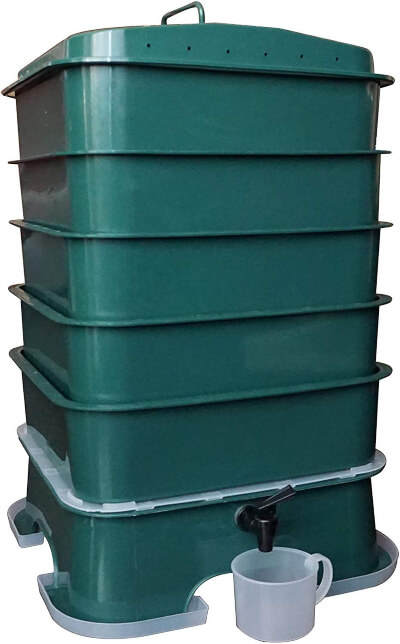
Source: amazon.com.au
This is a larger, high-volume worm composting bin with 5 trays and an easy worm tea collection spout. It contains an M-board to increase airflow in the farm, as well as a V-board for air-vented lid odour removal, moisture control and fruit fly control.
Ant traps are also included to help prevent invasions that can put the worms at risk. It’s easy to assemble and comes with a starter kit and manual, and the 1kg worms can consume 0.5 kg of food scraps per day on average. A 5-tray worm bin can house 5 kgs of worms to maximise output.
Pros
Cons
Our Compost Bin Top Picks for 2024
Top Pick for Best Home Composter


Source: kingswarehouse.com.au
There are few things that get gardeners more excited about gardening than compost. The pile of rotting foliage and kitchen waste in a sunny corner of the garden might sound dull and disgusting to most people, but the money you can save, and the goodness you can derive from your own backyard is magical in their own special way.
When you add a well-designed compost bin to the mix, it just sugar coats the deal, so I really am a fan of the Brown rattan composter, which blends in well with most gardens and doesn’t stand out like the traditional black plastic bins of years gone by.
Best Value Compost Bin


Source: kingswarehouse.com.au
If you’re after something really basic, but built for large capacity, then the 260L composter is ideal. It doesn’t look like much but it’s perfect for medium or large gardens, or families with a lot of kitchen waste.
The average garden will make around 150L of compostable waste from the kitchen over the course of a year, so having easy access to your compost bin is essential. It’s even better when you have enough space that you only have to deal with it once a year.
Best Premium Compost Bin


Source: amazon.com.au
If you’re looking for a compost bin that can handle anything you can throw at it and deliver high volumes of compost, the Joraform 'Big Pig' Rotational Composter is the best compost tumbler for you!
Despite the higher price, you still get great value for money, from the durable design and high-quality construction to the exceptional 270 litre capacity.
It’s able to process 25-30 litres of organic waste every week, including all food scraps, meat, fish, shellfish, household paper, and pet droppings. It comes with a 2-year warranty for your peace of mind too.
How to Use a Compost Tumbler
For simplicity in composting, it’s wise to select a compost tumbler. A novice gardener will find it supportive, and at the same time it’s an adequate tool for a municipality. There are different features offered in tumblers.
Many sit on wheeled frames for easy mobility. Some have to be rolled in order to turn the compost, and others have a hand crank. Either way, this method is less time consuming and physically easier than turning the natural fertiliser with a pitch fork.
A few generous cranks will turn the fins inside the drum and advance your production. Some tumblers are made of the same materials as approved food containers. They have insulated cells that retain heat.
This is essential to break down food scraps and yard debris. Handy features such as being lightweight, portable, and sealed for pest control add to the popularity of the compost tumbler.
What to Put in Your Compost
The art of composting is not overwhelming. If you have a covered container and a compost tumbler this system becomes a routine very quickly. Set the container on the kitchen counter and collect used kitchen paper, tea bags, fruit and vegetable peelings, coffee grounds and the filters. Toss in bread, egg shells, feathers, and corn cobs.
Don’t forget to include the dust from your vacuum cleaner, brown paper bags, saw dust, newspaper, and cereal boxes. Every few days just dump the container into the compost tumbler along with soft yard waste. Flower heads, grass clippings, and leaves help pave the way to a healthier garden and environment. Secure the lid on the tumbler, give it a few cranks and walk away.
Make sure the compost tumbler isn’t stuffed too full. It needs room to mix when the handle is cranked. Oxygen is necessary for rapid results. Crank the compost tumbler 2 or 3 times in each direction at least once a week.
It’s better to take a minute for cranking each day, but the decomposition will still take place if you miss a few days here and there. Some compost tumblers have an aeration system that helps decompose uneven ratios. However, it doesn’t hurt to be aware that there is somewhat of a recipe.
It makes the process move along faster and produces better quality compost. A simple guideline is to have equal amounts of green matter and brown matter. These will level out the nitrogen and carbon for a more even decomposition.
There’s no need to get all crazy and start measuring everything. A quick glance is enough to determine if there is far more of one colour than the other. Many gardeners find themselves really involved in composting and become fanatically precise. This is what makes them happy, but it’s absolutely not required.
What NOT to Include in Your Compost
There are bits of matter that are not recommended to be used in compost. Obviously, do not include anything that has been chemically treated, such as plastic or metal. Definitely skip bones, charcoal, and dog manure.
Walnut shells, grease, and meat are not advised, and neither are dairy products and rhubarb leaves. In the fall there is an abundance of brown leaves, so keep in mind not to put too many of those in the compost tumbler at one time.
The compost shouldn’t become dry in the sealed tumbler, but if this should happen add a bit of water — don’t drown it. Compost is ready to use when it’s crumbly and has an earthy smell.
Work it evenly into the topsoil of a garden and fill pots for other plants. Leave a bit of product in the compost tumbler to give your next batch a boost.
Making Compost Tea
Once you’ve made all that beautiful compost, the next challenge is deciding what to do with it all. You could dig some into an impoverished garden bed as soil improver, mulch your plants and even turn it back into potting mix or garden soil.
Yet, as the ultimate gardening resource, compost isn’t just limited to these options. In fact as a fertiliser it rates almost as high as worm castings. And depending on whose opinion you seek, it may even be better.
So while most gardeners have come to appreciate ‘worm wee’ as a bona fide organic liquid fertiliser, there are still a few that need convincing that compost tea is just as good.
In fact, using your compost as a tea rather than applying it straight to your garden beds will actually make it far more efficient in boosting your plants growth.
As a liquid, compost tea will cover nearly 3-4 times the area that normal compost alone could achieve and also prepare your plants to better source their own nutrients from the soil.
How to Make Compost Tea
For making compost tea the ratio of compost to water is approx. 1:10. So, if you have a 20L bucket then you will only need 2 kg of compost.
Heap the compost into a hessian or cheesecloth bag and add to your half-filled 20L bucket of water. Then increase the volume of water until it is completely full. Leave this to draw – as you would a tea bag – for about a week agitating a couple times per day. The agitation provides oxygen which is essential for the process.
When the tea is a dark earthy brown colour it’s ready to use. Dilute one part compost tea with 5 parts water and then you can start applying to your plants. And, they will love you for it.
As you can see, it’s not really a difficult process and if you’ve gone to all the effort of making your own compost then turning it into a liquid tea is merely a formality.
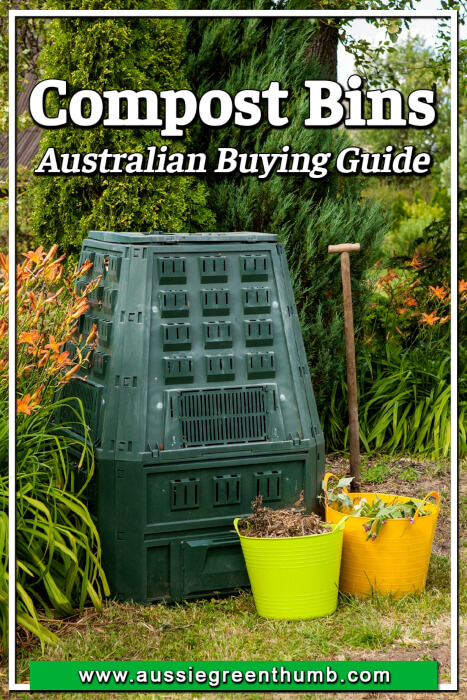
Start Gardening the Green Way with the Best Compost Bins of 2024!
We hope this article has helped you to find the right compost bin for you, whether it’s a compost tumbler, worm composting bins, stationary compost bins, or a convenient kitchen countertop compost bin!
When you’re ready to buy, remember to consider the volume of compost you want to achieve, how much organic waste you produce, and what type of bin would be best for you.
Look for features that help make mixing compost easier, that speed up the compost production process, and help keep pests out, and your garden will be enjoying nutrient-rich organic compost – that’s completely free – from the best compost bin in no time at all!
Published on August 12, 2022 by Gary Clarke
Last Updated on January 11, 2024

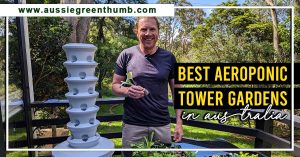
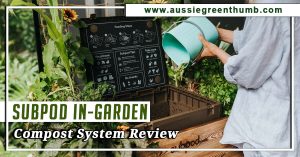
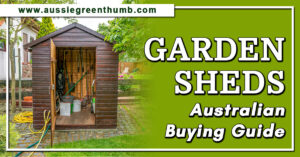
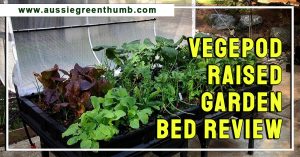
Wonderful article and very in-depth. We actually have tumbler and kitchen compost setup going, but I was looking for what the next steps were, and you answered all of my questions with your article. Thank you!
Hey Audrey,
Thank you so much for your kind words! We’re delighted to hear that you found the article helpful.
If you have any more questions or if there’s anything specific you’d like to know more about, feel free to ask. Happy composting!
Best regards,
Gary Clarke